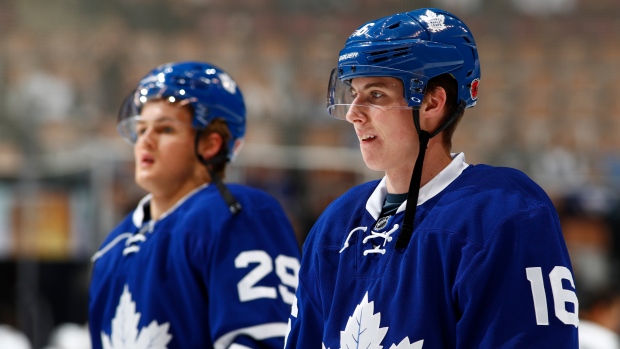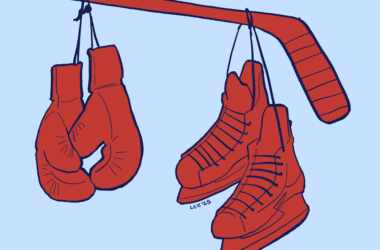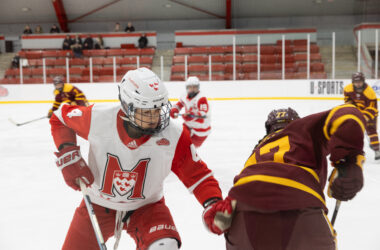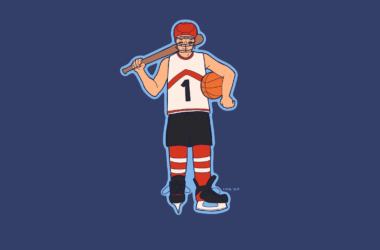The sophomore slump, an infamous term among pundits and fans in North American sports, happens when a player makes an immediate impact in their rookie year and follows up with a disappointing second season. The phenomenon is real for some players, who see their statistical outputs fall between their first and second campaigns, but no more than a myth for others who have no trouble beating their previous season’s marks.
Last year, the NHL had a standout rookie class. A trio of Toronto Maple Leafs—Auston Matthews, William Nylander, and Mitchell Marner—took the league by storm. Meanwhile, Winnipeg Jets sniper Patrik Laine, who scored three hat tricks before his 19th birthday, had a tremendous year of his own. Naturally, a season full of impressive rookie performances begs the question of whether those players are destined for regression or steady development into bonafide stars.
Many factors come into play when considering the potential for a sophomore slump: The first is shooting percentage. It’s common for players to score goals on a high percentage of their shots as rookies, but suddenly see that rate fall back into the normal range in their second season, leaving fans bewildered as their goal-scoring figures plummet.
Ice time also plays a role in slumping. The more a player plays, the greater the opportunity they have to score and assist goals. If an athlete gets less playing time in their second season, it is difficult for them to maintain or improve production. However, ice time is not the sole measure of opportunity: Audiences must also consider the quality of competition and zone starts. For example, coaches will adjust and try to play to a player’s strengths or push for the development of a more complete game. Matching up with weaker opposing lines and constant starts in the offensive zone can both create misleading stats.
Teammates can play a crucial role too, especially because roster change is inevitable every year. Sometimes, chemistry developed one year can be gone the next. Alternatively, playing with an established star can help boost a player’s production.
Finally, injuries can happen at any point, impeding a player’s progress during the season. The time it takes to get back into shape can also affect the player's performance for the next season. Looking back at past cases, hockey fans can better figure out how much of a role each factor plays.
By the numbers
Since the 2005-06 lockout, 26 rookies have scored at least 0.7 points per game (PPG). Four of those players were from this past season (Laine, Matthews, Marner, and Nylander).
Of the 22 others, nine improved upon their rookie campaign, seven maintained their level of performance, and six meaningfully deteriorated in their second seasons. Those six were Colby Armstrong, Brad Boyes, Ryan Nugent-Hopkins, Marek Svatos, Jeff Skinner, and Nathan MacKinnon.
For Armstrong and Svatos, a decline in shooting percentage was responsible for the drop. The former saw his rate drop by over 10 per cent after losing Sidney Crosby as a linemate. Meanwhile, the latter’s astronomically high percentage fell from nearly 20 per cent to a more normal 8.4 per cent as he scored 17 fewer goals in turn. Among the four breakouts from 2016-2017, however, only Laine and Matthews put forth particularly high shooting rates.
On the other hand, Nugent-Hopkins (shoulder), Skinner (concussion), and MacKinnon (broken foot) were all injured at some point during their sophomore seasons. Each individual’s performance suffered as a result, but once healthy, they returned to their rookie-season forms. Nugent-Hopkins has since turned into a two-way centre and managed 56 points in two consecutive seasons. Skinner, coming off a 37-goal season, looks much more like the prolific goal scorer many predicted after his rookie season. MacKinnon has bounced back with two consecutive 50-point years on a rebuilding Colorado Avalanche team.
It’s not likely for such high-calibre players to get worse, especially considering that the injured players bounced back once healthy again. Of the 22 rookies who managed 0.70 PPG, most have established themselves as consistent scoring threats in the league—a transition Laine, Matthews, Marner, and Nylander look to replicate—as long as they avoid injuries.
Individual comparisons

In terms of individual comparisons, Matthews’ rookie performance is most similar to Ilya Kolvachuk’s. Their shooting percentages, goal, and assist totals are comparable. Kolvachuk’s progress was encouraged by a significant bump in ice time and the gift of one of the best shots the NHL has ever seen. Time will tell if Matthews receives more ice time and is able to get into areas where he can convert a higher percentage of his opportunities.
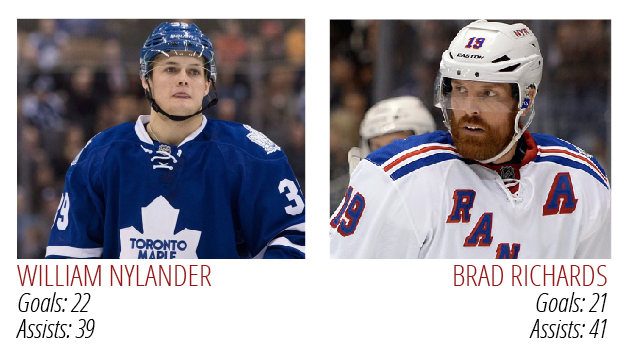
From a statistical standpoint, Nylander lines up closely with Brad Richards, with a similar number of goals, assists, and points. If Nylander can increase his shot totals and is afforded the same ice time, he should continue to improve in coming years.
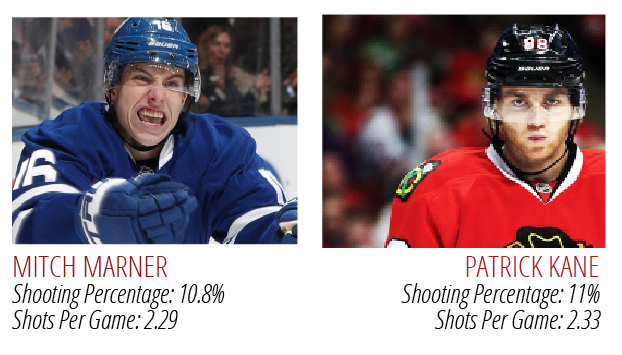
Marner can be likened to a young Patrick Kane. For such a dominant player, Kane’s shooting rate, assists, and goals per game were only just a bit better than Marner’s. If Marner is to follow in Kane’s footsteps, an increase in his shooting volume may help him net more goals in his sophomore season.
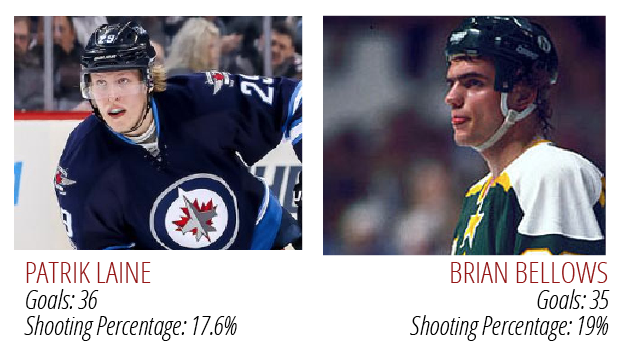
Laine has a high shooting percentage, similar to Brian Bellows, a forward who played for the Minnesota North Stars in the early ‘80s. Laine’s inflated shooting percentage could mean he is in for a decrease in scoring; however, it also means he could mirror Brian Bellows, who went on to score 485 goals in his career. If he can continue to shoot at this high rate and increase his total shots taken, he could be a 40-goal scorer next year.
As they move into their second seasons, these four standout rookies may not turn into the players they were compared to, but—if they can stay healthy—the numbers suggest that they aren’t due for a sophomore slump either. Each had very few unfavourable statistical anomalies, and both the Toronto Maple Leafs and the Winnipeg Jets should anticipate a good showing from their blossoming sophomores.
All statistics from hockey-reference.com
